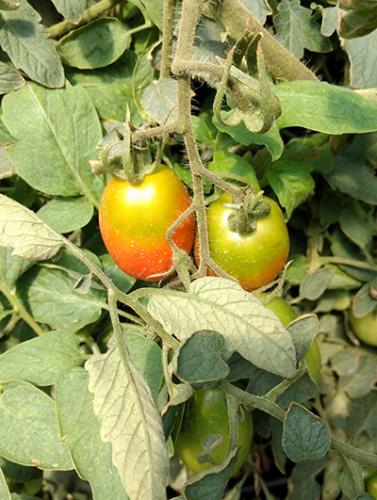East Michigan vegetable update — Aug. 9, 2017
Growers are moving sweet corn in volume this week, along with other warm-season crops.

Weather
Growing degree-days (GDD) in our region are behind the five-year average this last week, indicating cooler days and nights. Most of the Michigan State University Enviroweather stations in our region are still showing higher than average rainfall. However, growers in some regions are struggling with lack of rain.
The table below shows the GDDs base 50 degrees Fahrenheit since March 1, rainfall accumulations in inches since April 1, and soil temperature ranges (Fahrenheit over the last week) to date from MSU Enviroweather stations in the region.
|
GDD and rainfall accumulations as of Aug. 9, 2017 | ||||
|---|---|---|---|---|
|
Location |
GDD (+ added from last week) |
GDD 5-year average |
Rainfall (+ added from last week) |
Rainfall 5-year average |
|
1,681 (+ 111) |
1,740.8 |
13.15 (+ 0.71) |
10.91 |
|
|
1,671 (+ 100) |
1,751.5 |
9.34 (+ 0.00) |
11.97 |
|
|
1,867 (+ 112) |
1,871.2 |
16.02 (+ 0.91) |
13.98 |
|
|
1,739 (+ 105) |
1,800.3 |
14.19 (+ 0.5) |
12.12 |
|
|
1,704 (+ 102) |
1,772.7 |
19.28 (+ 0.37) |
12.53 |
|
|
1,685 (+ 93) |
1,776.5 |
12.26 (+ 0.51) |
13.86 |
|
|
1,606 (+ 100) |
1,677.9 |
22.38 (+ 1.31) |
12.73 |
|
|
1,727 (+ 103) |
1,792.0 |
14.39 (+ 0.73) |
11.31 |
|
|
1,819 (+ 118) |
1,823.5 |
13.86 (+ 1.34) |
12.26 |
|
|
1,590 (+ 102) |
1,677.9 |
13.74 (+ 0.49) |
13.66 |
|
Crops
Corn earworm catches in sweet corn remain low. There was a slight jump in earworm catch in west Michigan. Some growers are experiencing a bumper crop.
Machine-harvest of pickles continue. Surprisingly, despite excellent conditions, downy mildew has been hard to detect across the region. Some root and crown rot issues have cropped up in areas with heavy rains. Orondis works well as a downy mildew chemistry, as well as for phytophthora diseases. A special 24(c) label is required for a back-to-back use of this product if the total spray program is less than three sprays. The best time to apply it for phytophthora control is when fruit are 1 inch, with a follow-up application within 14 days (and outside the pre-harvest interval).
Winter squash and pumpkins are setting fruit. It is common to see flagging leaves on sunny, dry days. I have a six-variety butternut squash trial in Fenton, Michigan, this year, which I visited yesterday, Aug. 8. I wanted to see how the vining characteristics of each variety compete against weeds. The more vigorous vining types sent out one or two low-growing vines before weeds grew tall, but now weeds have occurred on all sides, shading out those leaves. The more semi-bush types were darker green with larger leaves. The mounding growth pattern appeared to reduce in-row weeds, and plants were slowly extending runners on top of emerged between-row weeds.
Fresh market tomato picks are continuing. Last week I mentioned calculating a Hartz ratio based on a soil test. This ratio can help guide fertility decisions regarding yellow shoulders, gray wall or uneven ripening. However, it does not work for bag-culture media. The soil media used in bag-culture has very high organic matter and most of its fertility is received through soluble fertilizers in irrigation water.

Yellow shoulders in tomato is sometimes referred to as gray wall, or occurs along with gray wall. It is an uneven ripening with multiple interacting causes, like sunlight and pH, but also a potassium fertilizer issue.
To prevent yellow shoulders in bag culture, make sure the water pH is in the low 6 range, ventilation and leaf coverage is adequate, and potassium levels are three times the levels of nitrogen. Some growers use a special high-K premix that already has triple the amount of K, like Miller’s Nutrichem (9-15-30) or potassium nitrate (13-0-46) and a micronutrient package like Helena’s Ele-Max Sulfur Complete SP or Huma Gro’s Max Pak.
If you use a soluble 20-20-20 plus micronutrients, you could also add potassium chloride (0-0-60) at two-thirds the rate of the 20-20-20. This approximates a 20-20-60 mix. However, MSU Extension suggests performing a jar test before mixing them in the same injection container to see if it forms a sludge.
Last week, I mentioned topping Brussels sprouts. I forgot to mention that it can also be important to prune the lowest two-thirds of leaves to allow for maximum sprout size. This also makes it easier to cut sprouts off of the stalk for cut sprout production, and for the customer if you sell the whole stalk “jingle bells” style.
Upcoming events
The Midwest Mechanical Weed Control Field Day is Sept. 26 at the MSU Horticulture Farm. For more information and registration, see “Midwest Mechanical Weed Control Field Day.”
Hotels are filling up for the Great Lakes Fruit and Vegetable EXPO, Dec. 5-7 in Grand Rapids, Michigan. The combination of grower-focused, research-backed presentations and an amazing exhibit hall make it a can’t-miss event.
Please contact me at phill406@msu.edu or 616-901-7513 to pick up any suspected disease samples from your farm, or send the diseased plant parts to MSU Diagnostic Services.



 Print
Print Email
Email


